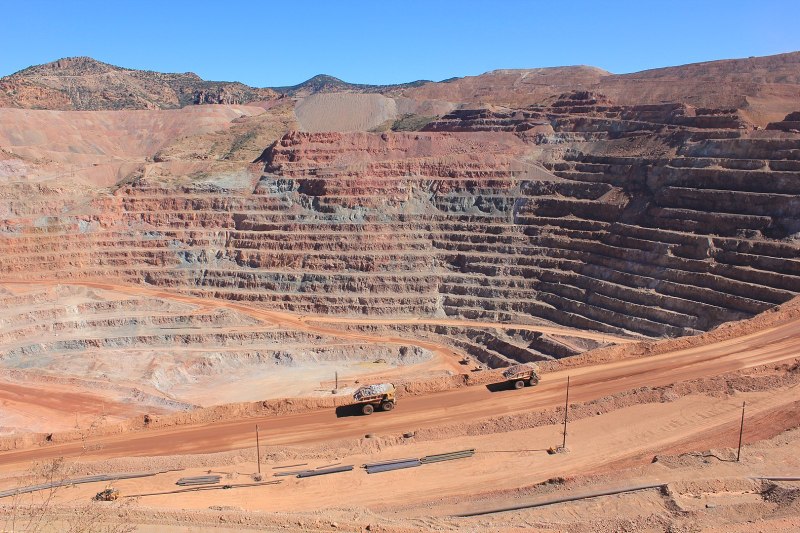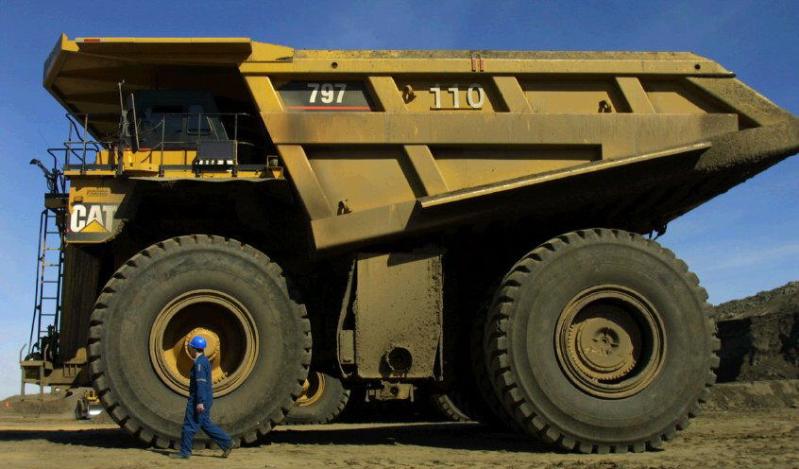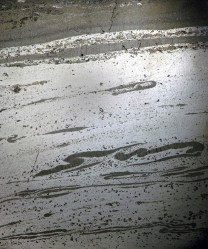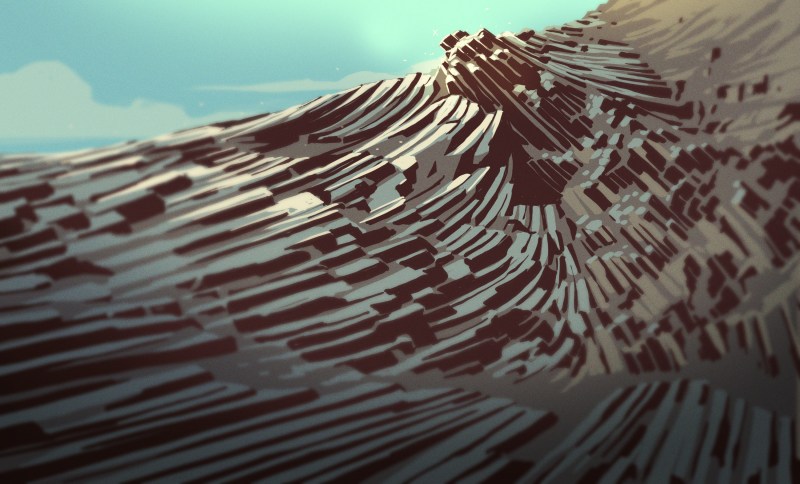In the last edition of our ongoing series on how planets get ore– those wonderful rocks rich in industrial minerals worth mining– we started talking about hydrothermal fluid deposits. Hydrothermal fluid is the very hot, very salty, very corrosive water that sweats out of magma as it cools underground and under pressure.
We learned that if the fluid stays in the magma chamber and encourages the growth of large crystals there, we call that a pegmatite deposit. If it escapes following cracks in the surface rock, it creates the characteristic veins of an orogenic deposit. What if the fluid gets out of the magma chamber, but doesn’t find any cracks?
Perhaps the surrounding rock is slightly permeable to water, and the hydrothermal fluid can force its way through, eating away at the base rock and remineralizing it with new metals as it goes. That can happen! We call it a porphyry deposit, particularly in igneous rock. It’s not exactly surprising that a hydrothermal fluid would find igneous rock: the fluid is volcanic in origin, after all, just like igneous rock. (That’s the definition of igneous: a rock of volcanic origin.) Igneous rocks, like granite, tend not to be terribly reactive so the fluid can diffuse through relatively unchanged.
Igneous rocks aren’t the only option, though. If the hydrothermal fluid hits carbonates, well, I did mention it’s acidic, right? Acid and carbonates are not friends, so all sorts of chemistry happens, such that geologists give the resulting metamorphic formation a special name: skarn. Though similar in origin, skarns are often considered a different type of deposit, so we’ll talk about the simpler case, diffusion through non-reactive rocks, before getting back to the rocks that sound like an 80s fantasy villain. (Beware Lord Skarn!)
Porphyry: Born to the Purple
In terms of ore deposits, humans have only started to exploit porphyry deposits relatively recently. Quite a few metals can be laid down, but a mine digging into a porphyry deposit is almost certainly chasing copper, to feed the industrial machine’s voracious appetite for the red metal. There’s generally going to be gold mixed in, and make no mistake; it’s not going to get left in the ground, but these are first and foremost copper mines.
Indeed, the gold, and lead, zinc, silver, and molybdenum that can also be present, are too diffusely mixed in with the copper to be left alone even if you wanted to. The copper, too, is very diffuse; these ores are low grade, with concentrations better measured in ppm than percent. That’s a consequence of the hydrothermal fluid spreading out through the rock, rather than concentrating its metals inside small veins.

It’s the low grade that explains why nobody bothered to call porphyry deposits ore until relatively recently: without explosives and powered earth moving equipment, the economics make zero sense. Mines in porphyry deposits tend to look like the one pictured: huge open pits, with equally huge equipment.

That isn’t to say these deposits were completely unknown; the stone that gives the deposits its name, porphyry, was quarried in antiquity. The difference between mining and quarrying in this context is that when you mine an ore, you’re going to refine it into something else; when you quarry rock, you’re going to use it as is. So an operation taking granite out of the ground and cutting it into slabs for countertops is a quarry; if they crush it and start doing chemistry to extract lithium, then it’s a mine.
Mining porphyry for gold or copper with muscle power is insane; taking the pretty purple stone called “imperial porphyry” to decorate the palace is not. Indeed, the birthing chambers in the Imperial Palace at Constantinople were walled in purple porphyry. The palace and the Porphyra, as it was called, are long gone, but an echo remains in the English language phrase “born to the purple”. To be born in the purple room was to be born into power, wealth, and privilege, which is how we use the phrase today. Still, for all that power, the Roman Empire couldn’t hope to do anything with porphyry other than use it as wallpaper or in sculpture. The metals were too diffuse; thus it was not ore.
There’s a decent chance we might find porphyry deposits on other planets, particularly Mars– but since other types of deposits with more concentrated ores will also be available, it’s not likely they will be mined for a very long time. As on Earth, simple economics will demand that any potential settlers “high grade” the planet– that is, take the higher grades of material first. If there were still large chunks of native copper, nobody would be building hundred-tonne trucks to dig up porphyry.

Skarn: Ugly Name, Pretty Rocks

The extra chemistry going on to create skarn deposits make them a different story; there you can find decent concentrations of things like tin, tungsten, manganese, copper, gold, zinc, lead, nickel, molybdenum and iron. Apparently the name comes from what they called waste rock in an old Swedish iron mine. The interesting chemistry — remember: acid fluid meeting basic, carbonate rock — also makes skarn deposits a good place to look for certain gemstones, like garnet, tourmaline, topaz, beryl, and even corundum– the mineralogist’s name for rubies and sapphires. Just as quartz comes in many colours depending on what trace elements are contaminating the basic crystal of SiO2, corundum, or Al2O3 , can take different colours as well. Rubies are red due to chromium contamination, for example.
So that’s what happens when the hydrothermal fluid gets loose and oozes through the base rock. What if it gets loose from the base rock entirely? Well, on land that’s a geyser and I’m not aware of any ore deposits directly formed by geysers. (Associated with, yes, but formed by? No.) Underwater it’s a different story: a plume of hot water coming into the ocean from beneath is famously known as a “black smoker” and that black smoke is mineralogically interesting.
VMS : When Alvin Goes Prospecting

The hot water hitting the cold sea water causes all sorts of things that were happily dissolved in the fluid to stop being happy, and stop being dissolved. In the short term, this leads to the delightfully creepy lightless ecosystems feasting on the chemical potential of the sulfides in the water around the Black Smoker. In the long term– the very, very long term, the geologic time long term, that is–the mostly-sulfide particulates in the “smoke” settle down into the local sediment to create “Volcanogenic Massive Sulfide” deposits, more commonly known by the acronym VMS. (I always misremember the V as “vented” , which is actually handy as it keeps me from getting confused from flood-basalt-generated sulfide melt deposits like Norilsk.)
Strictly speaking, the pretty picture of the black smoker spewing sulfide-particle smoke is not necessary: the cold seawater intermixing with hydrothermal fluids can happen entirely underground and the same reactions will occur. Either way, you can guess this sort of deposit is going to be restricted to watery worlds like Earth, Europa and other icy moons, or just possibly Mars.
The big problem with VMS deposits is that, as we do not typically want to do major mining operations on the sea floor, yet, they require the ocean to go away. This can happen through changes in sea level, or uplift of the rocks to some point above sea level. That’s not always going to happen, so there’s an idea out there that most VMS deposits will be underwater, and that this may represent a new frontier in mining. That idea deserves its own article someday, but for now, what would these hypothetical underwater miners be after?

Well, the same sulfide ores we find in terrestrial VMS deposits, presumably. The big players are iron, copper, silver, zinc and lead – VMS deposits represent decent fractions of the world’s production of the ores of those metals – but also a whole host of others. Ores of cobalt, tin, barium, selenium, manganese, cadmium, indium, bismuth, tellurium, gallium and germanium are found in, and extracted from, VMS deposits (often alongside the big players) to say nothing of the sulfur that makes up half or more of every sulfide mineral. (For those who slept through Chemistry class, a sulfide is a molecule with an S in it. My favourite sulfide mineral is realgar, which has the chemical formula Arsenic Sulfide: AsS. Some people have spirit animals; realgar is my spirit mineral.)
Unlike porphyry deposits, VMS deposits are rich enough they’ve been worked for time out of mind. The ore body that colours the Rio Tinto in Spain is a VMS deposit, and the mines there predate recorded history. Though ironically no longer operated by the Rio Tinto corporation, there remains a copper mine still working that deposit to this day, and other mines in nearby, related ore bodies.
SedEX is Not a Shipping Company

James St. John, CC BY 2.0
Closely related to VMS deposits are so-called SedEX and Mississippi Valley Type formations, though neither comes close to the economic relevance of VMS. SedEX stands for Sedimentary Exhallation, and these deposits are fine-grained and often relatively low grade Lead-Zinc sulfide deposits found in sedimentary rock. Economically viable concentrations of silver, copper, and tungsten can also be present. Like VMS deposits, they are created on seafloors, but unlike VMS deposits which are hosted in igneous rock, SedEX deposits are found– you guessed it– sedimentary rock. SedEX formation requires warm hydrothermal fluid to percolate up through sedimentary rocks to meet cold seawater. Since the world’s ocean is almost entirely undergirded by basaltic oceanic crust, that is, igneous rock, SedEX deposits aren’t nearly as common. It’s possible that they may occur on Mars, though I wouldn’t venture to guess if any sedimentary rocks exist under the ice of Europa or other icy moons, so Mars and Earth may be it for SedEX.
Mine the Mighty Miss?
Mississippi Valley Type (MVT) deposits are the last underwater ore deposit we’ll examine, and the last in the hydrothermal family. Don’t let the name fool you: they have nothing to do with rivers. It just so happens that the Mississippi Valley was once a vast, shallow inland sea, undergirded with carbonate rocks. In some parts of that valley, those carbonate rocks met a low-temperature hydrothermal fluid that left behind sulfide minerals when cooled by sea water. Organic matter rotting on the shallow seafloor or hydrocarbons underneath can sometimes be involved to provide the required sulfur, as the cool (under 150 C / 300 F) fluid may not be capable of carrying sufficient sulfur on its own.
Once again, these deposits are mostly a lead-zinc thing, but sometimes iron sulfides are present, too. Occasionally iron sulfides are the only thing present, but such pyrites are not considered worth mining in the current market. Carbonate-hosted Zinc sulfides, on the other hand, are the world’s main source of that metal. Given that they’re found worldwide and not only along the shores of the “Mighty Miss”, these deposits are also known as “Carbonate-hosted Lead-Zinc deposits” but that’s entirely too descriptive for my liking. Given that organic matter is involved in their formation, and the paucity of shallow carbonate-bottomed seas elsewhere in the solar system, MVT deposits are likely an Earth exclusive geologic gatcha.

And geology is a little bit like a gatcha system, when you think about it. You might know roughly what kind of rock types a given kind of ore deposit is found in, but until you make the draw – or drill core, as the case may be – you never know what you’re going to get. While this is the last article that’s going to cover hydrothermal ore deposits, there remains one last family of ore formation processes– quaternary processes, those that occur on surface and are ongoing in the present day. Maybe you’ll enjoy it, maybe not; that too, is a bit like gatcha. Regardless, that’s what we’re going to cover in the last work in the series. Stay tuned.
















I have enjoyed this series
Reminds me of 1st year science nerds. They kept talking about things like “orogeny” and “slaty cleavage”. More creative ones would talk about “geodesy” and the similar work “gilliad”.
Or the classic “schist happens”.
… or “sHiFt HaPpeNs” for computer folks
Speak for yourself dude. We were too busy slandering Pope John Paul II on YouTube to waste our lives on such trivial matters as opposite sex.
To be fair, those days were long before YouTube. While the geo kids were in their building, we were next door hammering out Fortran on punch cards.
As a long time professional metallic ore deposits geologist I appreciate your series to educate those with interest yet rarely have been exposed to this basic type of information. However, I would suggest editing by an ore deposits professional. Although your writings are largely factual there are a few statements marginal to reality and could easily be more factually framed.
I do run these drafts by a geologist of my close acquaintance, but they didn’t specialize in metallic ore deposits so all the not-quite-right oversimplifications are 100% on me. I do like how you phrased that, though: “marginal to reality”– no one has ever called me out on my errors in such a gentlemanly manner.
If there’s something you feel is too egregious to leave uncorrected, please do feel free to chime in! I actually appreciate the comments turning into errata; it beats being wrong.
A minor mis-spelling under the pit photo above, should read Morenci instead of Morcini.
Thank you, fixed.
Loving the long form on HAD!
Well, interesting for sure. Mostly familiar ground for me as a rock person.
One easily correctable thing is this:
“corundum– the mineralogist’s name for emeralds and sapphires. ”
Corundum is sapphire and ruby when in gem form, i.e. crystallized. Emerald is beryl; other color forms are aquamarine, heliodor, and goshenite.
D’oh! I don’t know how that happened– I even reference ruby and its dopant in the next sentence. Brain fart.
I think there’s a difference between crystalized and gem form, though I also think it’s totally qualitative. All I know is that line is set by the gemology people, and lots of crystals don’t make the cut. (pun intended)
I’m loving this series and hope HaD does many more of these long-form explanatory posts instead of continually highlighting some YouTuber who 3d printed some trash to make their weekly Algorithm Quota.
It has been really hard to leave positive comments on HaD lately, and I’m tired of being so negative.
Please keep doing more good stuff like this series.
Great stuff, I’ll keep reading as long as you keep them coming. I, too, enjoy these long-form articles.
Loving the series as well, and will probably use it as a quick explainer to non-geologist friends on how ores work (are born?).
Maybe you could have a follow-up on resources modelling, geostatistics and estimation in general?